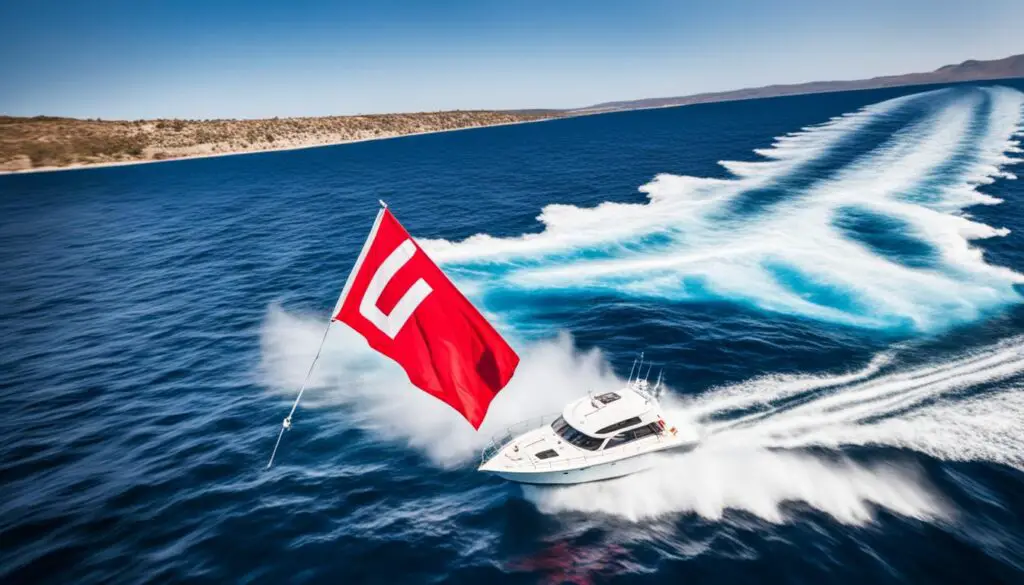Are you ready to embark on thrilling underwater adventures in the United States? Before diving in, it’s essential to familiarize yourself with the dive flag regulations that ensure your safety. Whether you’re snorkeling or scuba diving, understanding these regulations is crucial for maintaining safe practices and enjoying your underwater exploration to the fullest.
Key Takeaways:
- Dive flag regulations are vital for ensuring the safety of divers in the United States.
- They serve the purpose of alerting other watercraft operators to the presence of divers, minimizing the risk of accidents.
- Dive flags must meet specific requirements in terms of size, color, and placement.
- Divers should adhere to safety guidelines, such as staying within a specified distance from the flag and ascending/descending carefully.
- Complying with dive flag regulations is crucial for both divers and boaters to enjoy their activities safely.
The Purpose and Requirements of Dive Flag Regulations
Dive flag regulations serve a vital purpose in ensuring the safety of divers and other watercraft operators. These regulations are designed to alert boaters to the presence of divers in the water, reducing the risk of accidents and collisions that can occur when divers are not visible. By complying with dive flag regulations, divers can enhance their safety and enjoy their underwater adventures responsibly.
In the United States, dive flag regulations may vary slightly depending on the state, but there are some common requirements that all divers should be aware of. One of the primary requirements is that a dive flag must be prominently displayed on a buoy or a boat. The flag itself must meet specific size and color specifications to ensure visibility to other watercraft operators.
When using a dive flag, divers must also adhere to safety guidelines to further enhance their protection. This includes staying within a specified distance from the flag, usually around 100 feet, to maintain a safe zone for diving. Divers should also ascend and descend slowly to avoid decompression sickness, a potentially dangerous condition caused by the rapid changes in pressure experienced during diving.
It is crucial for divers to understand and comply with these requirements and safety guidelines. Failure to do so can put both the diver and other watercraft operators at risk. By following dive flag regulations, divers can contribute to a safer diving environment and help prevent unfortunate accidents or injuries.
Below is a summary of the purpose and requirements of dive flag regulations:
| Purpose of Dive Flag Regulations | Requirements for Dive Flags | Safety Guidelines for Divers |
|---|---|---|
| Alert other watercraft operators to the presence of divers | Prominently displayed on a buoy or a boat | Stay within a specified distance from the flag |
| Prevent accidents and collisions with divers | Meet specific size and color specifications | Ascend and descend slowly to avoid decompression sickness |

By understanding and respecting dive flag regulations, divers can contribute to the overall safety and enjoyment of their underwater experiences. It is essential for all divers to be aware of these regulations and to follow them diligently to ensure a safe and accident-free diving environment.
The Importance of Dive Flag Regulations for Safe Diving
Dive flag regulations play a crucial role in ensuring the safety of divers. These regulations are designed to alert boaters to the presence of divers in the water, reducing the risk of accidents and collisions. Accidental encounters between divers and boats can have severe consequences, including injuries or even fatalities, emphasizing the importance of adhering to dive flag regulations.
In addition to signaling the presence of divers, dive flag regulations serve as a visual reminder for both divers and other watercraft operators to follow safe diving practices. It is vital for divers to maintain a safe distance from the dive flag and ascend and descend slowly to avoid decompression sickness. By complying with these regulations, divers can minimize the risk of accidents and ensure their safety while enjoying underwater adventures.
Moreover, dive flag regulations encourage proper boating etiquette and responsible behavior in areas where diving is taking place. Boaters are reminded to steer clear of divers, maintain a safe distance, and navigate with caution. This promotes a harmonious coexistence between divers and boaters, ensuring a safer and more enjoyable experience for everyone involved.
To avoid accidents and promote diver safety, it is imperative that both divers and boaters understand and comply with dive flag regulations. By doing so, we can create a safer environment for underwater enthusiasts to explore the depths while minimizing the risk of accidents and injuries.
FAQ
What is the purpose of dive flag regulations?
Dive flag regulations serve the purpose of alerting other watercraft operators to the presence of divers in the water, reducing the risk of accidents and collisions.
What are the requirements for a dive flag?
A dive flag must be prominently displayed on a buoy or a boat, meeting specific size and color specifications.
What safety guidelines should divers follow when using a dive flag?
Divers should stay within a specified distance from the dive flag and ascend and descend slowly to avoid decompression sickness.
Why are dive flag regulations important for safe diving?
Dive flag regulations are of utmost importance for ensuring the safety of divers by minimizing the risk of accidents and collisions with boaters.
What can happen if divers and boats have accidental encounters?
Accidental encounters between divers and boats can result in serious injuries or fatalities.
How can dive flag regulations remind divers and boaters to follow safe practices?
Dive flag regulations serve as a visual reminder to divers and other watercraft operators to maintain a safe distance from divers and observe proper boating etiquette in diving areas.
Why is it crucial for divers to understand and comply with dive flag regulations?
Understanding and complying with dive flag regulations is essential for both divers and boaters to enjoy their activities safely.
Source Links
- https://www.wric.com/hill-politics/trumps-hush-money-case-set-for-critical-hearing-over-document-dump/
- https://www.harwichandmanningtreestandard.co.uk/news/national/24207345.suspects-appear-court-russian-concert-hall-attack/
- https://www.washingtontimes.com/news/2024/mar/24/vladimir-putin-declares-national-day-of-mourning-f/
